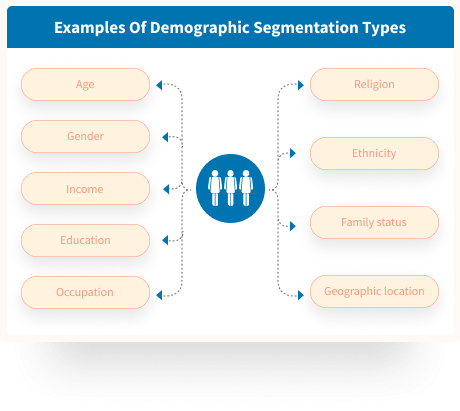
Learn more about Demographic Segmentation:

Demographic segmentation can be divided into two main categories: static segmentation and dynamic segmentation.
Static segmentation is based on factors that are fixed and unchanging, such as age or gender.
Dynamic segmentation considers factors that may change over time, such as location, education, or income level.
By combining both types of segmentation, marketers can gain a more complete understanding of their customers and target them with more tailored campaigns.
This is just one way marketers can use segmentation. Here are a few other common forms of segmentation:
Psychographic segmentation: Characteristics such as lifestyle, values, attitudes, interests, and personality traits. For example, a travel company might target adventure seekers who are interested in outdoor activities and have a high tolerance for risk.
Behavioral segmentation: Consumer behavior such as buying habits, brand loyalty, and product usage. For example, a SaaS platform may have different audiences, including agencies and consulting firms that deploy the platform for their clients and have multiple seats and use cases. They may market to these customers differently than those with verticalized use cases.
Firmographic segmentation: Company characteristics such as size, industry, and location. For example, a software company might target its marketing toward small businesses (5-100 employees) in the HR industry that have raised a series A funding round. Firmographic segmentation is like demographic segmentation at the company level, and it's primarily used in B2B marketing and sales (especially for account-based marketing).
The most advanced marketing programs use a combination of segmentation types to increase the chances that a campaign will resonate with a particular audience.
For example, product managers can identify users who have taken a specific action in their app (behavioral segmentation) and combine that with firmographic data (the user works at a tech company with 500 employees) and psychographic data to identify them as a product-qualified lead and push them to an upsell campaign.
Step 1 - Gather existing customer data
Marketers can gather existing data about their customers from various sources such as surveys or their website analytics tools of choice.
Advertising platforms, such as LinkedIn Ads, provide useful demographic data as well.
LinkedIn Ads offers a website tag for identifying demographic characteristics of website visitors, simplifying segment identification and targeted campaign creation.
Step 2 - Analyze and identify relevant segments
Analyze customer data against your business and marketing goals, such as conversions, conversion rate, and qualified leads.
One or more demographic characteristics likely stand out as performing higher or lower than average. This should form the basis of a marketer's use of segmentation in a campaign strategy.
Step 3 - Determine which demographic segments to use
After gathering data on the customer base or website visitors and identifying relevant demographic segments, marketers can prioritize the top segments to use in advertising and marketing campaigns.
It's helpful to revisit the broader business and product strategy. If, for instance, a company has many different products and one product line has been underperforming in relation to expectations.
It's helpful to incorporate other targeting criteria, such as behavioral data (purchase history, past interactions with the brand, website behavior, etc.)
All of this maximizes the chances that targeting subsections of an audience will be worth the time and additional investment in creative and resources.
Step 4 - Design campaigns based on these segments
At this stage, design strategy and creative, and set up demographic targeting using available tools and platforms.
This can include website personalization, content targeting, email segmentation, and advertising targeting.
Most advertising and email marketing platforms simplify audience targeting based on demographics. Although website personalization can be challenging, various web personalization software platforms support marketers.
Step 5 - Test, measure, iterate, and optimize
Testing is key to any marketing effort and segmentation should be no different.
There's always the possibility that targeting based on demographic makes no meaningful difference, in which case it's smart for marketers to dial back demographic targeting to reduce campaign management complexity.
It's important to track not only revenue and lead volume, but micro-conversions like click-through rate, engagement, and impressions. This gives marketers a holistic picture when compared against composition metrics like customer acquisition cost (CAC), return on ad spend (ROAS), and overall revenue driven across demographic segments.
If necessary, further refine segments or adjust ad targeting parameters to increase the efficiency of targeted campaigns, and never stop optimizing and improving them.
Website owners and marketers can gain a deeper understanding of their audience's job title, industry, company size, location, and seniority level.
The tool works by using LinkedIn's zero-party data to analyze the characteristics of the people who visit a particular website.
This data is then presented in a dashboard that displays various metrics and insights about the audience, including a breakdown of their job titles, industries, company sizes, and locations.
It also includes information on the seniority level of visitors, which can be particularly useful for B2B businesses looking to target decision-makers and influencers.
LinkedIn Website Demographics, in combination with any other website analytics tools in use at a company, will provide sufficient information to identify segments to use in campaign targeting.
Next, marketers can set parameters in their ads to target these segments on LinkedIn. LinkedIn Ads allows you to target ads and campaigns based on a wide range of demographic criteria, primarily focusing on job-related demographic dimensions such as job function, job title, company, company industry, job seniority, company size, location and country.
Using LinkedIn Ads, marketers also get granular tracking across targeted campaigns. Metrics on ads include:
Impressions: The number of times your ad was displayed
Clicks: Total chargeable clicks based on your campaign’s objective
Average CTR: Percentage of chargeable clicks relative to impressions (clicks divided by impressions)
Conversions: The total number of times people took a desired action after clicking on or seeing your ad
Conversion rate: Percentage of conversions relative to clicks (total conversions divided by clicks)
















